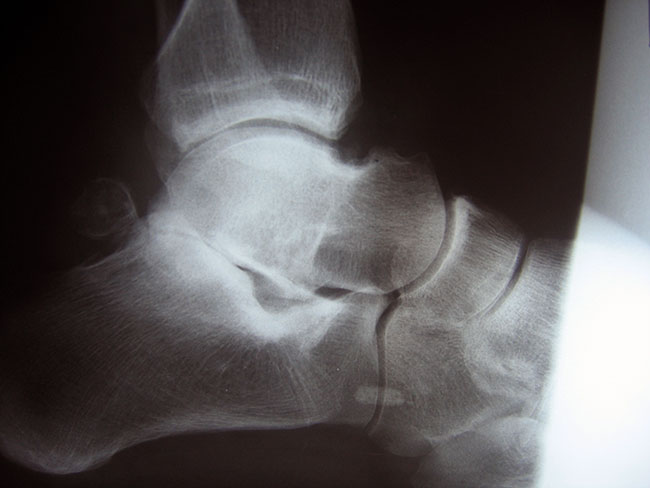
Office Appointments and Telemedicine with Dr. Carreira

You can also book an office appointment or a telemedicine visit by calling Dr. Carreira’s office at 404-355-0743. Book now.
What is Subtalar Arthritis?
Arthritis is the leading cause of disability in the United States. It can occur at any age, and literally means “pain within a joint.” As a result, arthritis is a term used broadly to refer to a number of different conditions.
Subtalar arthritis refers to degenerative changes in the cartilage of the subtalar joint. The most common cause of subtalar arthritis is traumatic injury to the hindfoot and is commonly seen after fracture to the calcaneus or talus. Presenting symptoms of subtalar arthritis include pain and swelling in the hindfoot. Weightbearing x-rays of the foot and ankle are primarily used to diagnose subtalar arthritis, but computed tomography (CT) can also be a useful tool in diagnosis.
How is Subtalar Arthritis Treated?
Although there is no cure for subtalar arthritis, there are many treatment options available. It is important to seek help early so that treatment can begin as soon as possible. With treatment, people with subtalar arthritis are able to manage pain, stay active, and live fulfilling lives, often without surgery.
If subtalar arthritis doesn’t respond to nonsurgical treatment, surgical treatment might be considered. The choice of surgery will depend on the type of arthritis, the impact of the disease on the joints, and the location of arthritis. Sometimes more than one type of surgery will be needed.

Subtalar arthritis treated with arthroscopic subtalar fusion, as seen on an X-ray before surgical treatment.
Subtalar arthrodesis fuses the bones of the joint completely, making one continuous bone. Two screws are inserted into the heel bone to hold the joint together while the fusion occurs.
A bone graft is sometimes needed if there is bone loss. The surgeon may use a graft (a piece of bone, taken from one of the lower leg bones or the wing of the pelvis) to replace the missing bone.
This surgery is typically quite successful. A very small percentage of patients have problems with wound healing. These problems can be addressed by bracing or additional surgery.
This type of surgery does not affect the up and down movement (dorsiflexion and plantarflexion) of the foot and ankle, but the side to side movement (inversion and eversion) of the back of the foot is limited after this surgery. Usually for most patients who require the subtalar arthrodesis, most of this side to side movement has already been lost. The lack of this side to side movement may be noticeable when walking on uneven ground surfaces.
General Factors of Postoperative Recovery
- You will not be walking on the leg at least 6 weeks. The exact time frame will be determined by xray follow-up and bone healing.
- In order to stay off your foot, you will need to use crutches, a walker, a wheelchair or a scooter type device called a roll about.
- There will be a hard plaster bandage applied to the leg for two weeks after surgery
- Your first follow up visit will be at approximately 2 weeks to remove the stitches
- We will usually apply a removable boot for you to wear starting at two weeks.
- If the surgery is on your left ankle, you should be able to drive an automatic vehicle at two weeks. If surgery is on the right foot, you may drive between 3 and 4 weeks.
- You may begin to put partial weight in the boot at about 6 weeks, depending upon your level of discomfort, and the instructions given to you.
- Physical therapy is helpful to regain the strength and movement of the ankle
- You should plan to use a physical therapist for about 1 to 2 months
- There will be moderate swelling of the foot, ankle and leg for about 6 months
- You will continue to improve your strength and movement for about 1 year after the surgery
- You can expect to have some soreness and aching for about 4 to 6 months after surgery
- Orthotic arch supports may be helpful in this recovery process.
Post Operative Course
Day 1
- Foot wrapped in bulky bandage and splint, ice, elevate, take pain medication
- Expect numbness in foot 12 24 hours then pain
- Bloody drainage is to be expected
- Do not change the bandage
Day 14
- The dressing is changed, xrays taken and a boot is applied
- No weight bearing for about 6 – 8 weeks
6 weeks
- The boot is removed, xrays are taken
- Continue full activities now in the boot and a gradual increase in weight bearing is initiated, with pain as a guide
12 weeks
- Start an exercise program
- Orthotic arch supports are likely ordered


